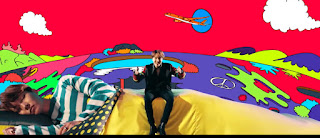Earlier this year, an uncut
35 mm print of Italian director Dario Argento’s 1977
horror masterpiece “Susperia” was found in pristine condition in the storage
room of an Italian cinema. Here it had been abandoned since the 1970s until
Chicago Cinema Society discovered the completely uncut six reel print with a
run time of 98 minutes and original dialogue. A copy of this print reached
Denmark in time for Halloween.
I went to see “Susperia” with my daughter who loves horror films as much as I do, and we were not disappointed. The version we saw was with an English-language dub, though, as originally, the actors’ dialogue was not properly recorded, as each actor spoke their native language, and then the voices were dubbed through additional dialogue recordings.
“Suspiria” has a fairly
simple plot. In fact, you could say that it is a fairy tale gone terribly wrong.
Suzy Bannion is an American ballet student who travels to Germany to join a
famous ballet school situated in the Black Forest. Upon her arrival she
discovers that something evil lurks within the walls of the age-old institution
and along with her new friend Sara, she tries to expose the horrible secret of
the academy.
What
makes “Susperia” a masterpiece is neither the plot nor the acting. Instead the
hallucinatory intensity of the film comes from Argento’s masterful use of deep
primary colours – “Suspiria” was one of the final feature films to be processed
in Technicolor- and from the eerie soundtrack by Italian progressive rock band
Goblin in collaboration with Dario Argento himself. The demonic score is going
to haunt you long after you have left the cinema. The lingering scenes show why
Argento is regarded a master of suspense and although the special effects of “Suspiria”
is no way near the standards of today, the sustained horror sequences are quite
gory and detailed.
As
soon as Suzy enters the Black Forest almost like a heroine from a Brothers
Grimm’s fairy tale, the tension starts to build, and we find ourselves trapped
along with Suzy in a hellish nightmare rich on stark colours, deep shadows, and
strange camera angels from which you can tell that “Suspiria” is indebted to
not only the German Brothers Grimm, but also to German Expressionist films.
References
to the British drama musical “The Red Shoes” (1948) and Lewis Carroll’s “Alice
in Wonderland” can be found too, but the vaguely menacing tone and the subconscious
fear that linger in every frame make “Suspiria” even more unsettling than any
Carroll fantasy.
No
wonder that Dario Argento is said to have influenced directors like Quentin
Tarantino and David Lynch and that “Susperia” itself has left a notable imprint
on films like “Crimson Peak” and “Black Swan”.
Dario
Argento is known for his misogyny and embedded hatred of
women, but I must admit that I didn’t detect any misogyny-vibes in “Suspiria”.
On the contrary, here all main characters are women, from the heroine Suzy (Jessica
Harper) over her sidekick Sara (Stefania Casini) to the mysterious
vice-directress Madam Blanc (Joan Bennett) and her frightening right hand, the
ballet instructor Miss Tanner (Alida Valli). Worth mentioning is also the
creepy cook (Franca Scagnetti) who is always in the company of her young son
Albert (played by Jacopo Mariani, who is partly Danish as his mother was born
in Copenhagen).
Apart from Albert whose
main function is to look creepy, there are only few male characters, all in the
category of supporting cast. Beside the blind pianist Daniel (Flavio Bucci) and
the scary handyman Pavlo (Giuseppe Transocchi), you’ll find a very young Udo
Kier as Dr Frank Mandel. There are no male heroes or antagonists, as the men
are reduced to minions, helpers or eye candy only – parts that usually belong
to women. Instead our heroine Suzy has to fight for herself to survive the
sickening nightmare in which she has been placed.
Four out of five stars:
****
P. S. The title “Suspiria”
means “sighs” or “deep breaths” and comes from “Suspiria de profundis” (a Latin
phrase meaning “sighs from the depths”), which is one of the best-known and
most distinctive literary works of the English essayist Thomas De Quincey. This
collection of short essays in psychological fantasy is often considered the
supreme prose fantasy of English literature.


